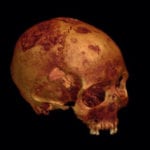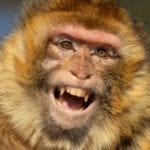 Music
Music  Music
Music  History
History 10 Less Than Jolly Events That Occurred on December 25
 Weird Stuff
Weird Stuff 10 Funny Ways That Researchers Overthink Christmas
 Politics
Politics 10 Political Scandals That Sent Crowds Into the Streets
 Weird Stuff
Weird Stuff Ten Bizarre Facts About The Doge Meme
 Our World
Our World 10 Ways Your Christmas Tree Is More Lit Than You Think
 Movies and TV
Movies and TV The 10 Coolest Stars to Set Sail on The Love Boat
 History
History 10 Things You Didn’t Know About the American National Anthem
 Technology
Technology Top 10 Everyday Tech Buzzwords That Hide a Darker Past
 Humans
Humans 10 Everyday Human Behaviors That Are Actually Survival Instincts
 Music
Music 10 Surprising Origin Stories of Your Favorite Holiday Songs
 History
History 10 Less Than Jolly Events That Occurred on December 25
 Weird Stuff
Weird Stuff 10 Funny Ways That Researchers Overthink Christmas
Who's Behind Listverse?

Jamie Frater
Head Editor
Jamie founded Listverse due to an insatiable desire to share fascinating, obscure, and bizarre facts. He has been a guest speaker on numerous national radio and television stations and is a five time published author.
More About Us Politics
Politics 10 Political Scandals That Sent Crowds Into the Streets
 Weird Stuff
Weird Stuff Ten Bizarre Facts About The Doge Meme
 Our World
Our World 10 Ways Your Christmas Tree Is More Lit Than You Think
 Movies and TV
Movies and TV The 10 Coolest Stars to Set Sail on The Love Boat
 History
History 10 Things You Didn’t Know About the American National Anthem
 Technology
Technology Top 10 Everyday Tech Buzzwords That Hide a Darker Past
 Humans
Humans 10 Everyday Human Behaviors That Are Actually Survival Instincts
10 Distant Human Ancestors and Relatives
Evolution is rarely direct. It is a meandering process which randomly produces creatures of bizarre forms. It does not consider what the creature’s progeny might become and streamline the process for future efficiency. It moves in all sorts of bizarre, indirect directions before producing the more familiar forms we know today. This is just as true of human evolution as it is of any other animal. We did not evolve via a smooth process from fish to monkeys to apes, but instead took many strange detours along the way. Starting from the moment we emerged onto land, here are some illustrations of these often-forgotten ancestors which together tell a peculiar story of our lineage.
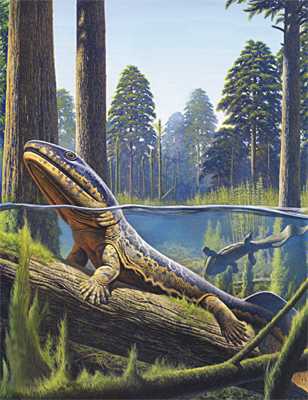
About 340 million years ago, something important happened. Some amphibians, who at the time grew larger than today’s giant river salamanders but lived similarly, began to produce amniotic eggs. These were eggs which had thin shells, allowing the embryo to breathe, but still solid enough to contain the water an embryo needs. The early creatures who laid such eggs were immediately successful, as this adaption enabled vertebrates to finally conquer land. The only other animals previously living on land were largely insects, so the amniotes had little resistance as they spread out and diversified into millions of different forms of life. One of the earliest was Casineria, a four-legged creature about the size and shape of a modern salamander, only 15cm long. It ate the insects that were plentiful, having had millions of years to themselves to multiply relentlessly on land. In fact, Casineria probably spent more time avoiding insects than eating them – due to a different air composition back then, insects were able to grow much larger; carnivorous dragonflies sported wingspans of over 70cm. Yet even evading insects five times its size did not hold Casineria back from thriving and ultimately becoming a key ancestor to the largest animals ever to exist on earth.
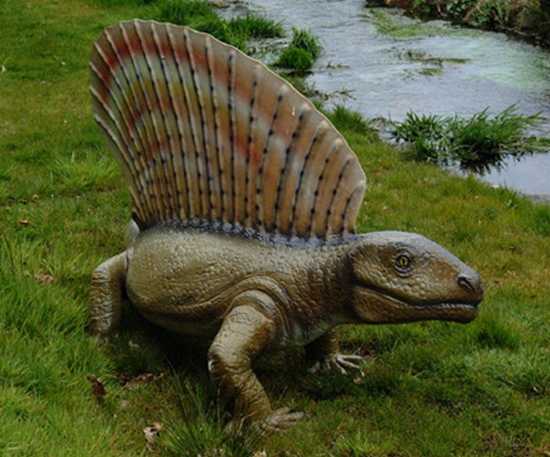
Edaphosauridae was a family of animals from around 300 million years ago. Edaphosaurs might have resembled dinosaurs, but they and their descendants were synapsids, mammal-like reptiles who diverged from true reptiles 320 million years ago. Edaphosaurids, and their most famous descendants, the Dimetrodons, both resembled large modern lizards with spectacular sails along their backs. The function of these sails is still not understood, but it is thought that they were either used for sexual displays or as a heat radiator, an important step towards evolving the thermo-regulated blood that all mammals have today. Edaphosaurids were about 3m long and were herbivores, eating leafy plants as grass did not evolve until long after they were extinct. Edaphosaurids and other synapsids were the dominant form of life on earth for millions of years until a mass extinction gave dinosaurs the opportunity to replace them.
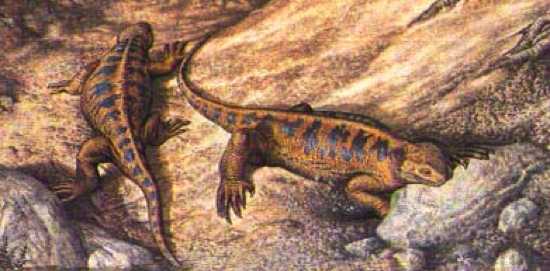
After Edaphosauridae, Caseidae was the second family of land herbivores. These synapsids existed around 270 million years ago, and were enormous, varying from 1m to 6m long. They typically had small heads and large, bulky bodies. Unusually for synapsids, the case ids had teeth which were almost all the same. Generally, a main distinction between mammals (or synapsids) and other vertebrates is the teeth: mammals have more than one type of specialized tooth in the mouth of each individual, whereas in reptiles, fish, and amphibians, all the teeth are uniform. The enormous Caseids with their unusual teeth had thin, snake-like tails and incredibly stocky short limbs, and could weigh in excess of 2 tons. They resembled komodo dragons with an enormously bloated, barrel-shaped abdomen, making them as tall as an adult human. It is not known if the stocky limbs, with their formidable claws, were as strong as they were so that they could dig for roots, fight potential predators, or if they were strong simply to be able to support their colossal bulk.
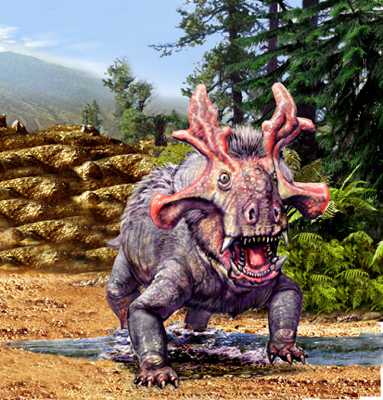
This was a group of synapsids from 260 million years ago whose name meant “terrible head.” They were large and had, most distinguishingly, hideous bony protrusions on their heads, thought to be used for sexual displays and fights. These creatures were less like reptiles and more like mammals: they had a fine coat of hair and walked more upright. Some were carnivores and some herbivores, and in general they grew to several meters long. Although they had many forms, they loosely resembled muscular hippopotamuses with delicate hair, large, interlocking teeth, and bizarrely shaped heads. Their distinguishing skulls, with all their terrible horns and bumps, had a larger brain cavity than their ancestors, beginning a trend that continues for mammals to this day: a gradually increasing brain size. Instead of relying on a perfectly adapted body, which of course becomes useless when the environment changes, mammals were beginning to rely instead on large brains with an increased ability to learn and adapt during their lifetime, making them capable of learning to live in a variety of environments rather than just one. This would prove to be mammals’ greatest strength over the next hundreds of millions of years.
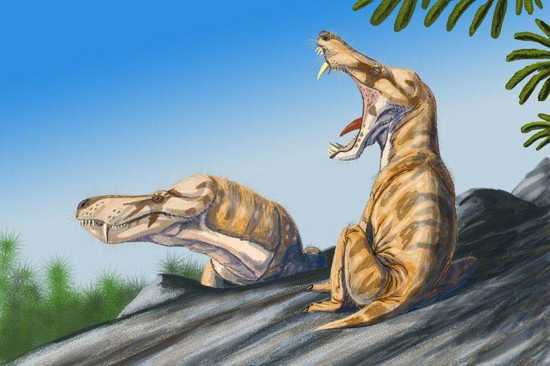
Around the time of the caesars, a new subgroup of synapsids developed: therapsids. These were more advanced than their forebears, and had legs which were positioned under their body to hold them up vertically, rather than sticking out sideways to hold them horizontally, like lizards. This enabled the development of more efficient walking rather than crawling. They had much more refined teeth, including for the first time incisors, canines, and molars. They also had the most recognizable mammalian traits: hair and lactation. One key therapsid of 250 million years ago was Pristerognathus. They were forest-dwelling, sleek, carnivorous hunters with large heads and prominent fangs. Although they were about the size of a housecoat, they were incredibly successful, and preyed on the many smaller synapsids of the time. Pristerognathus eventually died out completely in a mass extinction at the end of the Triassic period, which gave dinosaurs the opportunity to replace synapsids as dominant land animals. Nevertheless, the progeny of Pristerognathus survived until the demise of the dinosaurs, when they finally reclaimed their status as the dominant land animal on earth.

After the small Pristerognathus came the larger Cynognathus, a meter-long creature which resembled something of a strange mixture of a crocodile and a wolf. It had a long, reptilian snout which was 30% of its total body length, sporting diverse teeth with large protruding canines. It had a tapering crocodilian tail and sideways, sprawling reptilian forelegs, but it also had a torso with upright hind legs covered fur, like a mammal. Many fossils show that it had whiskers, an important mammal sensory device. Cynognathus existed some 240 million years ago and its fossils are today found worldwide, indicating just how successful and widespread these creatures were. In fact, due to the huge number of fossils, discoverers in various countries were often unaware that it existed elsewhere, and gave it a new name. It has been given an astounding fifteen different names due to this phenomenon, yet all are the same incredibly successful creature.
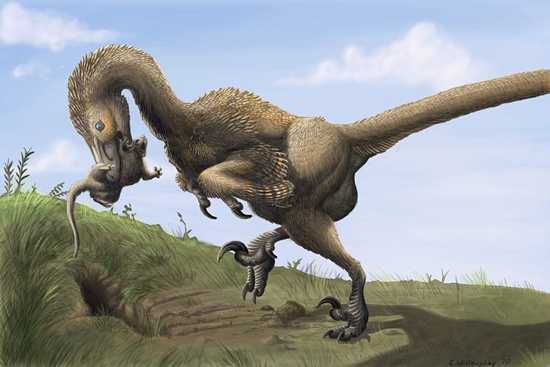
Extinctions are an important factor in speeding up evolution. Creatures which survive a mass extinction find themselves in a world devoid of many of their previous competitors, and are able to branch out and fill niches previously unattainable. The dinosaurs themselves did this at the expense of the synapsids and therapsids, which were quickly out-competed. The smaller therapsids were able to survive by accentuating their advantages over reptiles, and eked out an existence as rodent-like creatures. Multituberculata were not only around during the time of the dinosaurs, but their mammalian features are considered an important reason why they survived the dinosaurs’ own great extinction. Their diminutive body size meant they had small brains, but these brains were compact and had efficient designs. The multituberculata became more and more intelligent during their time on earth. These creatures were true mammals, and existed for longer than any other mammals in history: 120 million years in total, ending only 35 million years ago. Multituberculata were similar to rodents, and were mostly small, burrowing creatures covered in thick fur. Some lived in trees, as squirrels do today, and still others are thought to have swum. Instead of laying eggs like their ancestors, they gave birth to small, underdeveloped young as modern marsupials do, and fed them with milk from specialized sweat glands. Multituberculata finally starved to extinction when they were out-competed by their own progeny, the rodents.
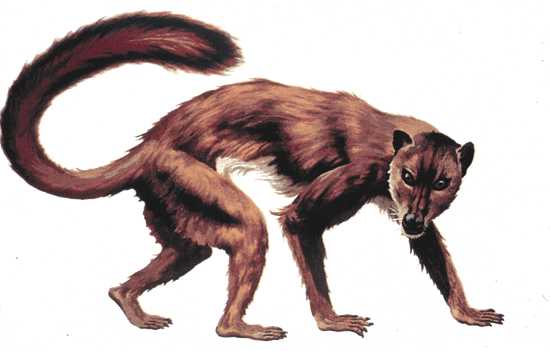
Some of the many descendants of Multituberculata had already taken to the trees, and about 55 million years ago, a creature we call Plesiadapis evolved as a distinct genus. It resembled a small, squirrel-like lemur, with a long bushy tail, elongated curved claws for gripping to help it climb, a long muzzle, a flat head, and eyes that faced sideways rather than forwards like ours, giving it only two-dimensional vision. Plesiadapis were adept climbers and are thought to be the ancestors of all primates. Their own ancestors in turn had been carnivorous tree-dwelling squirrel-like creatures, but Plesiadapis were evolving towards omnivority, and had sharp teeth suited to biting and tearing flesh as well as flat molars suitable for chewing leaves. The varied diet of modern primates is one of the main reasons why we evolved color vision, and so Plesiadapis most likely could also see in color. These arboreal creatures gave birth to fully-formed but helpless infants, as most modern mammals do.
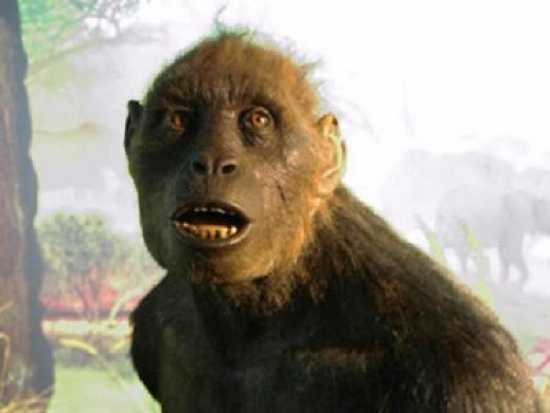
The early primates evolved into many forms, some of which still exist today. About 35 million years ago, a new group arose: the Old World monkeys. From the long curved claws of their ancestors they had evolved flat nails, and instead used dexterous, elongated toes to aid their climbing, making them more adaptable. Due to their lack of a specialized diet, Old World monkeys often do not find themselves wanting for food, and are able to live in large groups. Their survival as a group is largely dependent on group cohesion, so their brain size tends to be proportionate to the size of their social groups. The beautiful fluffy tails of their forebears, preserved in exquisite fossil records, have become limp and are no longer able to be moved much at all, and instead Old World monkeys use them as a counter-weight when balancing. About 30 million years ago, a genus named Proconsul found it more efficient to lose the tails altogether, retaining only a vestigial tailbone, and instead used a larger brain to help balance. Due to limitations in female pelvis size, this meant that the large brain would need to develop at least somewhat outside the womb, leading to a prolonged period of helplessness in infants while their brains acquired more and more information to help them survive. Proconsul gave rise to the first apes.
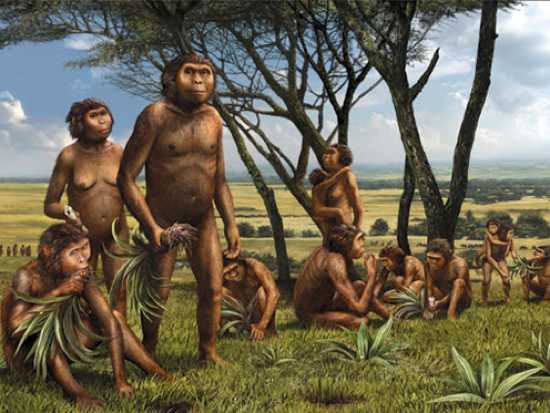
Apes in general rely more on large and adaptive brains than any specific physical adaptions. As a result, their offspring often take several years to be as capable as an adult, due to the slow but ultimately worthwhile process of learning all they need to know. Mothers spend this time teaching them about how to live in their particular area, and a strong mother-infant bond naturally results. A few of these fossil apes begin to show signs of walking upright. The opening in the skull where the spinal column leaves is at the back in most creatures, but is at the bottom of the skull in bipedal animals like ourselves, due to the posture needed when walking upright. 7 million years ago, a big-brained chimpanzee-like creature called Sahelanthropus showed this exact feature, but otherwise had all the adaptions to arboreal life. Its progeny, the hominids, began to lose their climbing adaptions and ventured out into open plains, accelerating the evolution towards upright walking. Their pelvises, feet, and spines began to resemble ours. Some hominids, like Paranthropus, had bony skull crests for attaching powerful jaw muscles. Others, like Homo erg aster, were lithe and much taller than we are today. These creatures, the hominids, grew brainier and used tools and fire to catch and cook food, making hunting and eating nutritionally more efficient, giving them the energy needed for their brains to grow still larger. We, Homo sapiens, evolved from these strange hominids, and although we don’t possess the largest brain of the hominids, we are the only one remaining today, the most widespread ape on earth.





